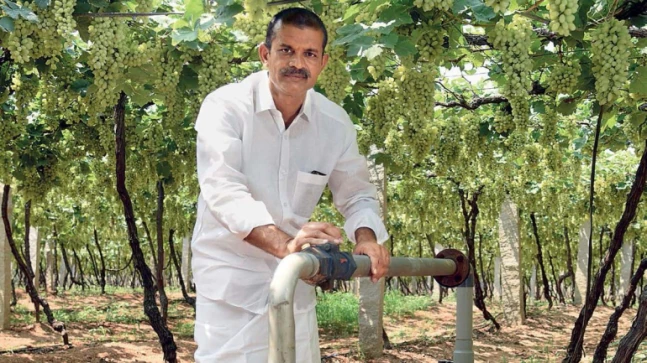A third standard dropout, M. Shivashankar Reddy recalls sleeping on gunny bags in his childhood. Today, the 49-year-old grows pomegranate, musk melon, grapes and vegetables on the three parcels of land he owns in Parasannayapalli village in Andhra Pradesh’s Ananthapuram district, earning Rs 3-4 lakh per acre. “We created 10 ponds across three parcels of land and adopted a drip irrigation system,” he says. “The water storage capacity ranges between 1 million and 3 million litres. The surface ponds recharge the groundwater level, especially during the rains.” He now has water available at a level of 150-200 ft in all 25 borewells on his lands. Reddy does not pump water from all of them; he uses water from only 10. “I ensure water from the ponds is never drained out.”
The neighbouring village of Venkatareddypalli has 70 artificial ponds, 12 check dams and two percolation ponds, all of which have been developed in the past six years with the help of the government. The village of 400 families has formed water user groups to support each other. Water is drawn through pipes from the nearby Penna river in the rainy season and stored in artificial ponds, which recharge the groundwater. Chavva Rajashekara Reddy and his three brothers, who live in the village, have created three large surface ponds on their lands, with water holding capacities of 120 million litres, 15 million litres and 5 million litres, respectively. The 120 million litre tank functions as a community pond, as it benefits other farmers in the region too by recharging the groundwater. “Initially, the farmers were resistant to the drought-proofing measures and scientific water management. Today, the results are unbelievable, as water is available at 200 feet. With drip irrigation, we are growing horticulture crops round the year. Our income per crop has tripled in the past six years,” says Rajashekara Reddy, who grows pomegranate, grapes and drumsticks on his land.
As part of the Per Drop More Crop component of the Prime Minister’s Kisan Sinchayee Yojana, Ananthapuram district constructed 51,825 water harvesting structures to increase its irrigation potential by 15,783 hectares. A District Irrigation Plan (DIP) was drawn up under which defunct water users’ associations were revived, farm ponds excavated and resource maps and mobile apps designed to guide farmers to the nearest water sources during dry spells. Additionally, farmers were encouraged and trained to use micro-irrigation methods such as drip and sprinkler systems, which now cover 39,801 hectares of land.
Simultaneously, the Andhra Pradesh Minor Irrigation Project (APMIP) and District Water Management Agency are providing subsidies and other promotions to convince, train and educate farmers on horticulture. So far, APMIP has spent Rs 1,500 crore on promoting horticulture in the district. Of the 1 million hectares of land under cultivation in the district, traditional crops are grown on 700,000 ha. and horticultural crops on another 202,000 ha.
“Ananthapuram district’s gross value addition to agriculture from horticulture is Rs 11,000 crore. We produce 5.8 million metric tonnes of fruits annually,” says Boya Surya Subbarayudu, project director of the Ananthapuram APMIP.
This article is auto-generated by Algorithm Source: www.indiatoday.in


